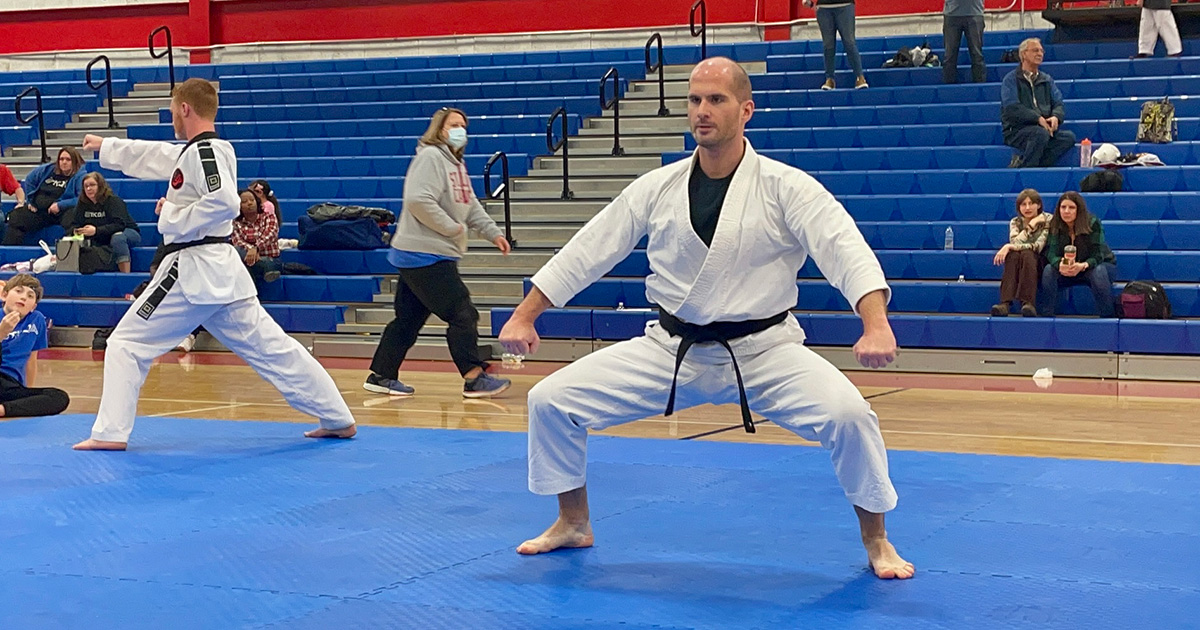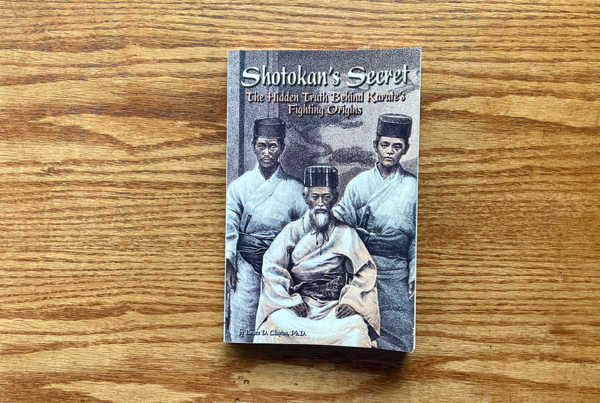Several of my students have recently indicated their desire to compete in upcoming martial arts tournaments.
This post will cover what I feel are the essentials of a forms competition, from practicing at home and in class to the day of the event.
In this post, I’ll explain:
- How forms competitors are grouped.
- The essential elements judges are looking for in form competitions.
- A drill you can perform on your own to help you get ready for a form competition.
- Other things you should consider for forms competition.
How Forms Competitions Are Grouped
Competitors in a forms competition are usually grouped by rank.
From there, they are further divided into groupings of age and gender.
For instance, you may see divisions for:
- White belt females, ages 8-10
- Green belt males, ages 13-15
- And so on.
For more local tournaments, the specific division will depend on who signs up for the event.
What Rules Usually State About Forms Competition
Sport Karate vs. Practical Karate
Before we dive into the rules, I wanted to point out that sport karate (or sport martial arts) forms are often not applicable in a self-defense situation.
In other words, competitors should understand that their tournament form may differ from what’s required for their next rank.
Metamora Martial Arts doesn’t require our students to compete to test for belt promotion, and we expect our students to understand the difference in what’s required to compete at a tournament compared to what’s required to test for the next rank.
A General Overview Of Forms Competition Rules
Martial arts tournament rules typically state that forms competitions are based on how an athlete performs, not what an athlete performs.
That’s because judges may not know the form they’re watching.
Forms vary by style and martial arts.
For example, a white belt form in karate may differ from a white belt form in taekwondo (see more on karate vs. taekwondo here).
As a result, judges are guided to score based on many qualities demonstrated by the athlete:
- Technique execution and application
- Balance
- Speed
- Power or intensity
- Stances
- Focus, control, or concentration
Athletes also generally must compete with a form that matches their division.
In other words, a brown belt shouldn’t be competing in the brown belt division with a white belt form—they should perform with a brown belt form (or an equivalent rank just under brown belt).
16 Ways You Can Practice Your Form For Your Next Tournament
I learned this drill from my first karate instructor and the founder of Metamora Martial Arts, Mr. Joe Chianakas.
I call it the 4×4 Drill.
Pick a form with which you want to compete.
Now, it’s time to get started.
1. Practice 4 Times For Power
Start facing a direction—it doesn’t matter which direction.
Practice your form as hard as you can.
Perform every movement like you’re breaking a board in front of you.
Even your bows and mudras.
Every technique is as hard as you can make it.
Your stances and balance may not be the best here, but that’s okay.
This segment isn’t for those qualities.
It’s for making each technique look as explosive and damaging as possible.
After you finish each form, you should be out of breath—you’ve just put everything you have into your form as if you were fighting real people.
Rest for a bit, then do it three more times.
2. Practice 4 Times For Speed
Turn counterclockwise to a new direction.
Switch your focus from power to speed.
Again, your balance and control may suffer here.
The point is to do your form as quickly as possible to see where you may want to add speedy elements to your form once you put everything together.
You should be out of breath after practicing each form, but you can rest for a bit before doing the next three repetitions.
3. Practice 4 Times For Grace
Turn counterclockwise to a new direction.
This time, focus on grace.
Your movements should be slow.
Your stances should be deep and long—see if you can get your front thigh parallel to the floor in a front stance, or both of your thighs parallel in a horse stance.
If your mobility and control is excellent, this is a great way to highlight high kicks.
Slowing down your movements exposes your weaknesses when you go hard and fast, forcing you to make corrections.
You’ll get a feel for where you can add slow elements in your competition form.
Your legs will likely be the most taxed muscles here because of how slow you’re doing the movements.
These forms should be at least half the speed as your regular form as if you were watching at 0.5x playback speed on YouTube.
In general, if you think you’re doing your form slowly, go slower.
4. Practice 4 Times For Combination (x4)
Turn counterclockwise to a new direction.
Now, mix these elements.
Perform a series powerfully.
Perform the next quickly.
Perform the next slowly.
Or, perform each technique in a series in a different way.
For example, block with power, punch with speed, and kick with grace.
Why This Drill Helps
I find this drill helpful for several reasons:
- You showcase the artistic side of martial arts. Show off those high kicks and deep stances. Use varying tempos to take your judges and your audience on a journey with you. You don’t have to just go through the motions, but can put your unique stamp on your form and performance.
- You don’t get stuck in one direction. In class, we often face the same way each time. When we turn in a different direction, it can throw us off. With this drill, you are constantly moving, so the mental hurdle of facing an unfamiliar direction is obliterated.
- You disguise repetition. It’s easy to hear “practice your form” from your instructor. But in this format, you can break what feels like a long practice into four distinct segments. Neither of the four segments feels too long to practice, unlike it might practicing your form 16 times.
- BONUS TIP: Record yourself on your phone. You don’t have to every time, but film different repetitions to see what you like. You may like a certain technique or series for power. Keep that and play with the other parts. Video is a great training tool to use at home or a supplement to use with your instructor.
Other FAQs To Know About Form Competition
First-time competitors should know a few other elements about form competition:
When and How To Bow
In general, you can’t bow too much.
Here are some typical places where you may bow:
- When your center judge bows your division in and out.
- When you are stepping into the ring.
- Before and after you announce yourself (if announcing is required—see the next section).
- Before and after your performance.
- When you are leaving the ring as your next competitor steps in.
Is Announcing Required? And What Should You Say?
I don’t see announcing as required too often these days, but it’s good to know how to prepare for it.
Announcing teaches competitors how to be confident and clear in front of a judging panel.
Usually, I’ll find out on the day of a tournament whether announcing is required or even accepted.
For beginners, my preferred script to keep it simple includes name, school, and form—sometimes, style is included.
Here’s what a basic script might look like:
“Honorable judges, my name is Adam Bockler. I represent shinmei shorin-ryu karate with Metamora Martial Arts. Today, I will perform Taikyoku. May I begin?”
How Forms Competitions Are Scored
Scoring a forms competition is entirely up to the tournament promoter or sanctioning organization.
Since each event’s instructions are unique, we’d need to refer to the event’s rules to understand how judges will be instructed to score.
Though, in my experience, even though judges receive specific instructions, they aren’t always followed.
Regardless of the specific scoring strategy, judges will evaluate each performance to determine first, second, third (and so on) place finishes for each division.
Ready? Begin!
And that’s it.
You’re ready to compete with your form at your next event.
I’ve used this strategy to win multiple forms competitions over the years with various katas.
If you’re reading this and you have a go-to forms preparation strategy, contact me if you’re willing to share!
Interested in learning more about doing best on tournament day? Head over to this post to read 11 tips students and parents should know.





